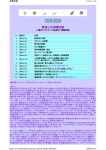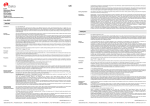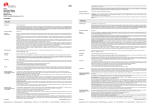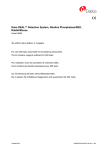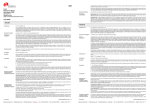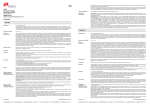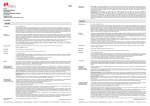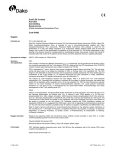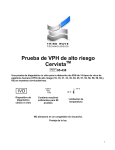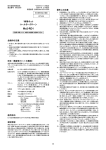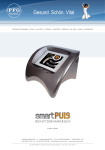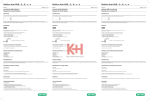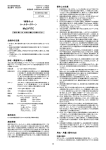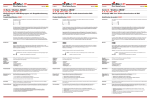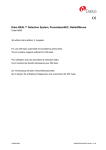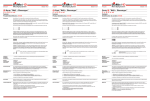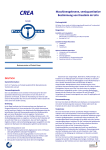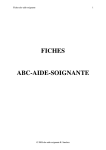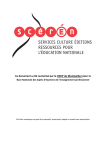Download FLEX Monoclonal Mouse Anti-Human CD30 Clone Ber-H2
Transcript
FLEX Monoclonal Mouse Anti-Human CD30 Clone Ber-H2 Ready-to-Use (Dako Autostainer/Autostainer Plus) Staining interpretation Cells labeled by the antibody display membrane and/or a dot like cytoplasmic staining (1). Performance characteristics Normal tissues: In tonsil/lymph node sections, the antibody labels scattered large lymphoid cells localized around lymph follicles and at the margin of germinal centres. In paraffin sections, but not in frozen sections, a subpopulation of plasma cells is positive. In the thymus, only a few medullary thymocytes are labeled. In a large range of non-lymphoid tissues, no labeling with the antibody was observed with two exceptions, the cytoplasm of exocrine pancreatic cells was labeled diffusely in both frozen and paraffin-embedded sections, and the cytoplasm of a proportion of cerebral cortical neurons and Purkinje cells of the cerebellum were labeled in paraffin-embedded sections, but not frozen sections. The antibody did not react with any resting peripheral lymphocytes or monocytes (1). Activated perifollicular lymphocytes in tonsil show a moderate to strong staining reaction. Abnormal tissues: In paraffin-embedded sections of anaplastic large-cell lymphoma, the antibody strongly labeled all of 60 cases. No differences were observed in labeling between T-, B- or null-cell phenotypes. In paraffin-embedded sections of Hodgkin’s disease, 61/61 cases of nodular sclerosis, 53/53 cases of mixed cellularity, 8/10 cases of lymphocyte-depleted, and 4/13 cases of lymphocyte-predominance type were labeled by the antibody. In frozen sections, all of 108 tested cases were positive (1). In non-Hodgkin’s lymphomas, a weak staining of a subpopulation of tumor cells was seen in 11/11 cases of lymphomatoid papulosis, 62/93 cases of cutaneous-, pleomorphic-, angioimmunoblastic-, and lymphoepithelioid- T-cell lymphomas, and in 53/332 cases of chronic lymphocytic-, centrocytic- (small cleaved), centroblastic-centrocytic-, centroblastic-, and immunoblastic- B-cell lymphomas in frozen and paraffin-embedded sections, whereas a strong staining was seen in 20/67 cases of lymphoplasmocytoid/cytic- B-cell lymphomas (1). In nonlymphoid neoplasms, the antibody labels tumor cells in 48/50 cases of pure embryonal carcinoma (EC), or EC components of germ cell tumors. In cases of mixed and pure germ cell tumors without EC components 0/27 was labeled. In activated mesothelium, 16/28 pleural and peritoneal effusions were positive with the antibody, small foci of tumor cells in 2/8 mesotheliomas were also positive (5). No labeling was observed in 8 cases of Kaposi’s sarcoma and 8 cases of teleangiectatic granuloma (9). A diffuse or finely granular cytoplasmic staining was observed in the endothelial cells in 21/33 cases of haemangioma, 4/10 cases of lymphangioma, 4/9 cases of mixed tumors with both components, and 6/10 cases of angioleiomyoma (9). Code IS602 ENGLISH Intended use For in vitro diagnostic use. FLEX Monoclonal Mouse Anti-Human CD30, Clone Ber-H2, Ready-to-Use, (Dako Autostainer/Autostainer Plus), is intended for use in immunohistochemistry together with Dako Autostainer/Autostainer Plus instruments. This antibody labels anaplastic large-cell lymphoma (ALCL) and Reed-Sternberg cells, and is useful for the identification of ALCL and as a secondary marker for Hodgkin’s disease (1). The clinical interpretation of any staining or its absence should be complemented by morphological studies using proper controls and should be evaluated within the context of the patient's clinical history and other diagnostic tests by a qualified pathologist. Synonym for antigen Ki-1 antigen (1). Summary and explanation CD30 is a transmembrane cytokine receptor belonging to the tumor necrosis factor (TNF) receptor superfamily. Mature CD30 has a molecular mass of 120 kDa and is derived from a 90 kDa precursor protein (2). The extracellular domain of CD30 is homologous to that of TNF receptor superfamily members, whereas there is no homology in the cytoplasmic domain, suggesting major differences in signalling mechanisms (3). The intracellular part of CD30 possesses kinase activity, indicating that CD30 plays a role in regulating the function, differentiation and/or proliferation of normal lymphoid cells (2). A soluble 85 kDa form of CD30, sCD30, released from the membrane-bound molecule by proteolytic cleavage, can be detected in the sera of patients with CD30-expressing neoplasms (3, 4). CD30 expression is found on Hodgkin and Reed-Sternberg (H-RS) cells, anaplastic large-cell lymphoma cells, and on activated B and T lymphocytes (2). In non-lymphoid tissues and neoplasms, CD30 expression has been confirmed in embryonal carcinomas, seminomas, decidual cells and mesotheliomas (5). Refer to Dako’s General Instructions for Immunohistochemical Staining or the detection system instructions of IHC procedures for: 1) Principle of Procedure, 2) Materials Required, Not Supplied, 3) Storage, 4) Specimen Preparation, 5) Staining Procedure, 6) Quality Control, 7) Troubleshooting, 8) Interpretation of Staining, 9) General Limitations. Reagent provided Ready-to-use monoclonal mouse antibody provided in liquid form in a buffer containing stabilizing protein and 0.015 mol/L sodium azide. Clone: Ber-H2 (1). Isotype: IgG1, kappa. Immunogen Co cell line established from a patient with Hodgkin’s disease of T-cell lineage (1, 6). Specificity Anti-Human CD30, clone Ber-H2, was clustered as anti-CD30 at the Fourth International Workshop and Conference on Human Leucocyte Differentiation Antigens (7). SDS-PAGE analysis of immunoprecipitates formed between lysate of 125I-labeled COS cells transfected with cDNA encoding CD30 and the antibody shows reaction with a 120 kDa protein corresponding to CD30. Mock-transfected COS cells were negative. The epitope recognized by the antibody is located between amino acid residues 112 and 412 (8). The antibody labels cell lines derived from Hodgkin’s disease, L428, L540, L591, Co, Ho and KM-H2; HTLV-1 transfected T-cell lines, Hut-102 and MT2; EBV-transformed B cell lines (non-Burkitt), B95-8 (monkey), BJA-B and Cess; and the myeloid cell line, K 562 (1). Precautions 1. For professional users. 2. This product contains sodium azide (NaN3), a chemical highly toxic in pure form. At product concentrations, though not classified as hazardous, sodium azide may react with lead and copper plumbing to form highly explosive build-ups of metal azides. Upon disposal, flush with large volumes of water to prevent metal azide build-up in plumbing. 3. As with any product derived from biological sources, proper handling procedures should be used. 4. Wear appropriate Personal Protective Equipment to avoid contact with eyes and skin. 5. Unused solution should be disposed of according to local, State and Federal regulations. Storage Store at 2-8 °C. Do not use after expiration date sta mped on vial. If reagents are stored under any conditions other than those specified, the conditions must be verified by the user. There are no obvious signs to indicate instability of this product. Therefore, positive and negative controls should be run simultaneously with patient specimens. If unexpected staining is observed which cannot be explained by variations in laboratory procedures and a problem with the antibody is suspected, contact Dako Technical Support. Specimen preparation including materials required but not supplied Staining procedure including materials required but not supplied (115243-004) Dako Denmark A/S The antibody can be used for labeling formalin-fixed, paraffin-embedded tissue sections. Tissue specimens should be cut into sections of approximately 4 µm. Pre-treatment with heat-induced epitope retrieval (HIER) is required using Dako PT Link (Code PT100/PT101). For details, please refer to the PT Link User Guide. Optimal results are obtained by pretreating tissues using EnVision FLEX Target Retrieval Solution, Low pH (50x) (Code K8005). Paraffin-embedded sections: Pre-treatment of formalin-fixed, paraffin-embedded tissue sections is recommended using the 3-in-1 specimen preparation procedure for Dako PT Link. Note: After staining the sections must be dehydrated, cleared and mounted using permanent mounting medium. Deparaffinized sections: Pre-treatment of deparaffinized formalin-fixed, paraffin-embedded tissue sections is recommended using Dako PT Link and following the same procedure as described for paraffin-embedded sections. After staining the slides should be mounted using aqueous or permanent mounting medium. The tissue sections should not dry out during the treatment or during the following immunohistochemical staining procedure. For greater adherence of tissue sections to glass slides, the use of FLEX IHC Microscope Slides (Code K8020) is recommended. The recommended visualization system is EnVision FLEX, High pH, (Dako Autostainer/Autostainer Plus) (Code K8010), replacing the High pH Target Retrieval Solution from this kit with EnVision FLEX Target Retrieval Solution, Low pH (50x) (Code K8005). The staining steps and incubation times are pre-programmed into the software of Dako Autostainer/Autostainer Plus instruments, using the following protocols: Template protocol: FLEXRTU2 (200 µL dispense volume) or FLEXRTU3 (300 µL dispense volume) Autoprogram: CD30 (without counterstaining) or CD30H (with counterstaining) Note: The Autoprogram must be updated to reflect the change in target retrieval solution. In the Programming Grid, go to the Edit Lists tab, choose Primary Antibody FLEX CD30, MxH, IS602, change pre-treatment from EnVision FLEX TRS High pH to EnVision FLEX TRS Low pH. The Auxiliary step should be set to “rinse buffer” in staining runs with ≤10 slides. For staining runs with >10 slides the Auxiliary step should be set to “none”. This ascertains comparable wash times. All incubation steps should be performed at room temperature. For details, please refer to the Operator’s Manual for the dedicated instrument. If the protocols are not available on the used Dako Autostainer instrument, please contact Dako Technical Services. Optimal conditions may vary depending on specimen and preparation methods, and should be determined by each individual laboratory. If the evaluating pathologist should desire a different staining intensity, a Dako Application Specialist/Technical Service Specialist can be contacted for information on re-programming of the protocol. Verify that the performance of the adjusted protocol is still valid by evaluating that the staining pattern is identical to the staining pattern described in “Performance characteristics”. Counterstaining in hematoxylin is recommended using EnVision FLEX Hematoxylin, (Dako Autostainer/Autostainer Plus) (Code K8018). Non-aqueous, permanent mounting medium is recommended. Positive and negative controls should be run simultaneously using the same protocol as the patient specimens. The positive control tissue should include tonsil and the cells/structures should display reaction patterns as described for this tissue in “Performance characteristics” in all positive specimens. The recommended negative control reagent is FLEX Negative Control, Mouse, (Dako Autostainer/Autostainer Plus) (Code IS750). IS602/EFG/SSM/20011.10.26 p. 1/4 | Produktionsvej 42 | DK-2600 Glostrup | Denmark | Tel. +45 44 85 95 00 | Fax +45 44 85 95 95 | CVR No. 33 21 13 17 FRANÇAIS Utilisation prévue Pour utilisation diagnostique in vitro. FLEX Monoclonal Mouse Anti-Human CD30, Clone Ber-H2, Ready-to-Use, (Dako Autostainer/Autostainer Plus), est destiné à une utilisation en immunohistochimie avec les instruments Dako Autostainer/Autostainer Plus. Cet anticorps marque les cellules de lymphomes anaplasiques à grandes cellules (LAGC) et les cellules de Reed-Sternberg, et est utile pour l’identification du LAGC et comme marqueur secondaire pour la maladie de Hodgkin (1). L’interprétation clinique de toute coloration ou son absence doit être complétée par des études morphologiques en utilisant des contrôles appropriés et doit être évaluée en fonction des antécédents cliniques du patient et d’autres tests diagnostiques par un pathologiste qualifié. Synonyme de l’antigène Antigène Ki-1 (1). Résumé et explication Le CD30 est un récepteur transmembranaire de cytokine appartenant à la superfamille des récepteurs du facteur de nécrose tumorale (FNT). Le CD30 mature a une masse moléculaire de 120 kDa et est dérivé d’une protéine précurseur de 90 kDa (2). Le domaine extracellulaire du CD30 est homologue à celui des membres de la superfamille des récepteurs FNT, alors qu’il n’existe pas d’homologie dans le domaine cytoplasmique, indiquant des différences majeures dans les mécanismes de signalisation (3). La partie intracellulaire du CD30 possède une activité kinase, ce qui indique que le CD30 joue un rôle de régulation, de différenciation et/ou de prolifération des cellules lymphoïdes normales (2). Une forme soluble de 85 kDa du CD30, le sCD30, libérée par la molécule liée à la membrane par clivage protéolytique, peut être détectée dans le sérum des patients dont des néoplasmes expriment le CD30 (3, 4). L’expression du CD30 est observée dans les cellules de Hodgkin et Reed-Sternberg (H-RS), dans les cellules des lymphomes anaplasiques à grandes cellules, et sur les lymphocytes B et T activés (2). Dans les néoplasmes et les tissus non lymphoïdes, l’expression du CD30 a été confirmée dans les carcinomes embryonnaires, les séminomes, les cellules déciduales et les mésothéliomes (5). Se référer aux Instructions générales de coloration immunohistochimique de Dako ou aux instructions du système de détection relatives aux procédures IHC pour plus d’informations concernant les points suivants : 1) Principe de procédure, 2) Matériels requis mais non fournis, 3) Conservation, 4) Préparation des échantillons, 5) Procédure de coloration, 6) Contrôle qualité, 7) Dépannage, 8) Interprétation de la coloration, 9) Limites générales. Réactifs fournis Anticorps monoclonal de souris prêt à l’emploi fourni sous forme liquide dans un tampon contenant une protéine stabilisante et 0,015 mol/L d’azide de sodium. Clone : Ber-H2 (1). Isotype : IgG1, kappa. Immunogène Lignée cellulaire Co établie à partir d’une lignée de lymphocytes T de la maladie de Hodgkin (1, 6). Spécificité L’anticorps Anti-Human CD30, clone Ber-H2 a été classé comme un anti-CD30 à la Fourth International Workshop and Conference on Human Leucocyte Differentiation Antigens (Quatrième Conférence et Atelier Internationaux sur les Antigènes de Différenciation des Leucocytes Humains) (7). L’analyse par immunoblot PAGE en présence de SDS des immunoprécipités formés entre le lysat des cellules COS marquées à l’iode 125I transfectées par l’ADNc codant pour le CD30 et l’anticorps présente une réaction à une protéine de 120 kDa correspondant au CD30. Les cellules COS faussement transfectées étaient négatives. L’épitope reconnu par l’anticorps est situé entre les résidus d’acides aminés 112 et 412 (8). L’anticorps marque les lignées cellulaires dérivées de la maladie de Hodgkin, L428, L540, L591, Co, Ho et KM-H2 ; les lignées de lymphocytes T transfectées par HTLV-1, Hut-102 et MT-2 ; les lignées de lymphocytes B transformées par l’EBV (non Burkitt), B95-8 (singe), BJA-B et Cess, ainsi que la lignée de cellules myéloïdes K 562 (1). Précautions 1. Pour utilisateurs professionnels. 2. Ce produit contient de l’azide de sodium (NaN3), produit chimique hautement toxique dans sa forme pure. Aux concentrations du produit, bien que non classé comme dangereux, l’azide de sodium peut réagir avec le cuivre et le plomb des canalisations et former des accumulations d’azides métalliques hautement explosifs. Lors de l’élimination, rincer abondamment à l’eau pour éviter toute accumulation d’azide métallique dans les canalisations. 3. Comme avec tout produit d’origine biologique, des procédures de manipulation appropriées doivent être respectées. 4. Porter un vêtement de protection approprié pour éviter le contact avec les yeux et la peau. 5. Les solutions non utilisées doivent être éliminées conformément aux réglementations locales et nationales. Conservation Conserver entre 2 et 8 °C. Ne pas utiliser après la dat e de péremption indiquée sur le flacon. Si les réactifs sont conservés dans des conditions autres que celles indiquées, celles-ci doivent être validées par l’utilisateur. Il n’y a aucun signe évident indiquant l’instabilité de ce produit. Par conséquent, des contrôles positifs et négatifs doivent être testés en même temps que les échantillons de patient. Si une coloration inattendue est observée, qui ne peut être expliquée par un changement des procédures du laboratoire, et en cas de suspicion d’un problème lié à l’anticorps, contacter l’assistance technique de Dako. Préparation des échantillons y compris le matériel requis mais non fourni L’anticorps peut être utilisé pour le marquage des coupes de tissus inclus en paraffine et fixés au formol. L’épaisseur des coupes d’échantillons de tissu doit être d’environ 4 µm. Un prétraitement avec démasquage d’épitope induit par la chaleur (HIER) est nécessaire avec le Dako PT Link (Réf. PT100/PT101). Pour plus de détails, se référer au Guide d’utilisation du PT Link. Des résultats optimaux sont obtenus en prétraitant les tissus à l’aide de la EnVision FLEX Target Retrieval Solution, Low pH (50x) (Réf. K8005). Coupes incluses en paraffine : le prétraitement des coupes tissulaires fixées au formol et incluses en paraffine est recommandé à l'aide de la procédure de préparation d'échantillon 3-en-un pour le Dako PT Link. Remarque : après coloration, les coupes doivent être déshydratées, lavées et montées à l’aide d’un milieu de montage permanent. Coupes déparaffinées : le prétraitement des coupes tissulaires déparaffinées, fixées au formol et incluses en paraffine, est recommandé à l’aide du Dako PT Link, en suivant la même procédure que pour les coupes incluses en paraffine. Après coloration, un montage aqueux ou permanent des lames est recommandé. Les coupes de tissus ne doivent pas sécher lors du traitement ni lors de la procédure de coloration immunohistochimique suivante. Pour une meilleure adhérence des coupes de tissus sur les lames de verre, il est recommandé d’utiliser des lames FLEX IHC Microscope Slides (Réf. K8020). Procédure de coloration y compris le matériel requis mais non fourni Le système de visualisation recommandé est le EnVision FLEX, High pH, (Dako Autostainer/Autostainer Plus) (Réf. K8010), en remplaçant la solution High pH Target Retrieval Solution de ce kit par la solution EnVision FLEX Target Retrieval Solution, Low pH (50x) (Réf. K8005). Les étapes de coloration et d’incubation sont préprogrammées dans le logiciel des instruments Dako Autostainer/Autostainer Plus, à l’aide des protocoles suivants : Protocole modèle : FLEXRTU2 (volume de distribution de 200 µL) ou FLEXRTU3 (volume de distribution de 300 µL) Autoprogram : CD30 (sans contre-coloration) ou CD30H (avec contre-coloration) (115243-004) Dako Denmark A/S IS602/EFG/SSM/20011.10.26 p. 2/4 | Produktionsvej 42 | DK-2600 Glostrup | Denmark | Tel. +45 44 85 95 00 | Fax +45 44 85 95 95 | CVR No. 33 21 13 17 Remarque : Le programme automatique doit être actualisé pour refléter le changement de Target Retrieval Solution. Dans la grille de programmation, aller dans l’onglet de modification des listes, choisir l’anticorps primaire FLEX CD30, MxH, IS602, modifier le prétraitement pour remplacer EnVision FLEX TRS High pH par EnVision FLEX TRS Low pH. L’étape Auxiliary doit être réglée sur « rinse buffer » lors des cycles de coloration avec ≤10 lames. Pour les cycles de coloration de >10 lames, l’étape Auxiliary doit être réglée sur « none ». Cela garantit des temps de lavage comparables. Toutes les étapes d’incubation doivent être effectuées à température ambiante. Pour plus de détails, se référer au Manuel de l’opérateur spécifique à l'instrument. Si les protocoles ne sont pas disponibles sur l’instrument Dako Autostainer utilisé, contacter le service technique de Dako. Les conditions optimales peuvent varier en fonction du prélèvement et des méthodes de préparation, et doivent être déterminées par chaque laboratoire individuellement. Si le pathologiste qui réalise l’évaluation désire une intensité de coloration différente, un spécialiste d’application/spécialiste du service technique de Dako peut être contacté pour obtenir des informations sur la re-programmation du protocole. Vérifier que l'exécution du protocole modifié est toujours valide en vérifiant que le schéma de coloration est identique au schéma de coloration décrit dans les « Caractéristiques de performance ». Il est recommandé d’effectuer une contre-coloration à l’aide de EnVision (FLEX Hematoxylin, (Dako Autostainer/Autostainer Plus) (Réf. K8018). L’utilisation d’un milieu de montage permanent non aqueux est recommandée. Des contrôles positifs et négatifs doivent être réalisés en même temps et avec le même protocole que les échantillons du patient. Le contrôle de tissu positif doit comprendre l’amygdale et les cellules/structures doivent présenter des schémas de réaction tels que décrits pour ces tissus dans les « Caractéristiques de performance » pour tous les échantillons positifs. Le contrôle négatif recommandé est le FLEX Negative Control, Mouse, (Dako Autostainer/Autostainer Plus) (Réf. IS750). Interprétation de la coloration Les cellules marquées par l’anticorps présentent une coloration cytoplasmique en pointillés et/ou membranaire (1). Caractéristiques de performance Tissus sains : Dans les coupes de tissus d’amygdale/de ganglions lymphatiques, l’anticorps marque les grandes cellules lymphoïdes disséminées situées autour des follicules lymphoïdes et en marge des centres germinatifs. Dans les coupes incluses en paraffine, mais pas dans les coupes congelées, une sous-population de cellules plasmatiques est positive. Dans le thymus, seuls quelques thymocytes médullaires sont marqués. Dans un grand nombre de tissus non lymphoïdes, aucun marquage par l’anticorps n’a été observé, à deux exceptions près, le cytoplasme des cellules pancréatiques exocrines a été marqué de manière diffuse à la fois dans les coupes congelées et incluses en paraffine, et le cytoplasme d’un certain pourcentage de neurones corticaux cérébraux et de cellules de Purkinje du cervelet a été marqué dans les coupes incluses en paraffine, mais pas dans les coupes congelées. L’anticorps n’a pas réagi aux monocytes ou aux lymphocytes périphériques au repos (1). Les lymphocytes périfolliculaires activés dans l’amygdale présentent une coloration modérée à forte. Tissus tumoraux : Dans les coupes de tissus inclus en paraffine de lymphomes anaplasiques à grandes cellules, l’anticorps a fortement marqué chacun des 60 cas. Aucune différence de marquage n’a été observée entre les phénotypes de lymphocytes B, T ou de cellules nulles. Dans les coupes incluses en paraffine de la maladie de Hodgkin, 61 cas sur 61 de sclérose nodulaire, 53 cas sur 53 de cellularité mixte, 8 cas sur 10 de déplétion lymphocytaire et 4 cas sur 13 de type à prédominance lymphocytaire ont été marqués par l’anticorps. Dans les coupes congelées, chacun des 108 cas testés s’est avéré positif (1). Dans les lymphomes non hodgkiniens, une faible coloration d’une sous-population de cellules tumorales a été observées dans 11 cas sur 11 de papulose lymphomatoïde, 62 cas sur 93 de lymphomes à lymphocytes T cutanés, polymorphes, angio-immunoblastiques et lymphoépithélioïdes, et dans 53 cas sur 332 de lymphomes à lymphocytes B lymphocytaires chroniques, centrocytiques (à petites cellules clivées), centroblastiquescentrocytiques, centroblastiques, et immunoblastiques dans des coupes congelées et incluses en paraffine, tandis qu’une forte coloration a été observée dans 20 cas sur 67 de lymphomes à lymphocytes B lymphoplasmocytoïdes/lymphoplasmocytaires (1). Dans les néoplasmes non lymphoïdes, l’anticorps marque les cellules tumorales dans 48 cas sur 50 de carcinome embryonnaire pur, ou les éléments embryonnaires de tumeurs à cellules germinales. Dans les cas de tumeurs à cellules germinales mixtes et pures sans éléments embryonnaires, aucun cas n’a été marqué sur 27. Dans le mésothélium activé, 16 cas sur 28 d’effusions pleurales et péritonéales se sont révélé positifs à l’anticorps, de petits foyers des cellules tumorales ont également été positifs dans 2 mésothéliomes sur 8 (5). Aucune coloration n’a été observée sur 8 cas de sarcome de Kaposi et 8 cas de granulome télangiectasique (9). Une coloration diffuse ou granulaire à points fins a été observée dans les cellules endothéliales dans 21 cas d’hémangiome sur 33, 4 cas de lymphangiome sur 10, 4 cas de tumeurs mixtes à deux composants sur 9 et 6 cas d’angioléïomyome sur 10 (9). Vorbereitung der Probe und erforderliche, aber nicht mitgelieferte Materialien Der Antikörper eignet sich zur Markierung von formalinfixierten und paraffineingebetteten Gewebeschnitten. Gewebeproben sollten in Schnitte von ca. 4 µm Stärke geschnitten werden. Die Vorbehandlung durch hitzeinduzierte Epitopdemaskierung (HIER) mit Dako PT Link (Code-Nr. PT100/PT101) ist erforderlich. Weitere Informationen hierzu siehe PT Link-Benutzerhandbuch. Optimale Ergebnisse können durch Vorbehandlung der Gewebe mit EnVision FLEX Target Retrieval Solution, Low pH (50x) (Code-Nr. K8005) erzielt werden. Paraffineingebettete Schnitte: Die Vorbehandlung der formalinfixierten, paraffineingebetteten Schnitte mit dem 3-in-1-Probenvorbereitungsverfahren für Dako PT Link wird empfohlen. Hinweis: Nach dem Färben müssen die Schnitte dehydriert, geklärt und mit permanentem Einbettmedium auf den Objektträger aufgebracht werden. Entparaffinierte Schnitte: Eine Vorbehandlung der entparaffinierten, formalinfixierten, paraffineingebetteten Gewebeschnitte mit Dako PT Link nach demselben Verfahren, wie für die paraffineingebetteten Schnitte beschrieben, wird empfohlen. Die Objektträger nach dem Färben mit einem wässrigen oder permanenten Einbettmedium bedecken. Die Gewebeschnitte dürfen während der Behandlung oder des anschließenden immunhistochemischen Färbeverfahrens nicht austrocknen. Zur besseren Haftung der Gewebeschnitte an den Glasobjektträgern wird die Verwendung von FLEX IHC Microscope Slides (Code-Nr. K8020) empfohlen. Färbeverfahren und erforderliche, aber nicht mitgelieferte Materialien Das empfohlene Visualisierungssystem ist EnVision™ FLEX, High pH (Dako Autostainer/Autostainer Plus) (Code-Nr. K8010), wobei die High pH Target Retrieval Solution dieses Kits durch EnVision FLEX Target Retrieval Solution, Low pH (50x) (Code-Nr. K8005) ersetzt wird. Die Färbeschritte und Inkubationszeiten sind in der Software der Dako Autostainer/Autostainer Plus-Geräte mit den folgenden Protokollen vorprogrammiert: Matrix-Protokoll: FLEXRTU2 (200 µL Abgabevolumen) oder FLEXRTU3 (300 µL Abgabevolumen) Autoprogram: CD30 (ohne Gegenfärbung) oder CD30H (mit Gegenfärbung) Hinweis: Autoprogram muss aktualisiert werden, um die Änderung bei der Demaskierungslösung zu berücksichtigen. Im Programmierraster zur Registerkarte Edit Lists (Listen bearbeiten) gehen, Primary Antibody FLEX CD30, MxH, IS602 auswählen und die Vorbehandlung von FLEX TRS High auf FLEX TRS Low ändern. Bei Färbedurchläufen mit höchstens 10 Objektträgern sollte der „Zusatz“-Schritt auf „Pufferspülgang“ eingestellt werden. Für Färbedurchläufe mit mehr als 10 Objektträgern den „Zusatz“-Schritt auf „Keine“ einstellen. Dieses gewährleistet vergleichbare Waschzeiten. Alle Inkubationsschritte sollten bei Raumtemperatur durchgeführt werden. Nähere Einzelheiten bitte dem Benutzerhandbuch für das jeweilige Gerät entnehmen. Wenn die Färbeprotokolle auf dem verwendeten Dako Autostainer-Gerät nicht verfügbar sind, bitte den Technischen Kundendienst von Dako verständigen. Optimale Bedingungen können je nach Probe und Präparationsverfahren unterschiedlich sein und sollten vom jeweiligen Labor selbst ermittelt werden. Falls der beurteilende Pathologe eine andere Färbungsintensität wünscht, kann ein Anwendungsspezialist oder Kundendiensttechniker von Dako bei der Neuprogrammierung des Protokolls helfen. Die Leistung des angepassten Protokolls muss verifiziert werden, indem gewährleistet wird, dass das Färbemuster mit dem unter „Leistungsmerkmale“ beschriebenen Färbemuster identisch ist. Die Gegenfärbung in Hämatoxylin sollte mit EnVision™ FLEX Hematoxylin, (Dako Autostainer/Autostainer Plus) (Code-Nr. K8018) ausgeführt werden. Empfohlen wird ein nichtwässriges, permanentes Fixiermittel. Positiv- und Negativkontrollen sollten zur gleichen Zeit und mit demselben Protokoll wie die Patientenproben getestet werden. Das positive Kontrollgewebe sollte Mandelgewebe enthalten und die Zellen/Strukturen müssen in allen positiven Proben die für dieses Gewebe unter „Leistungsmerkmale“ beschriebenen Reaktionsmuster aufweisen. Das empfohlene Negativ-Kontrollreagenz ist FLEX Negative Control, Mouse, (Dako Autostainer/Autostainer Plus) (Code-Nr. IS750). Auswertung der Färbung Mit diesem Antikörper markierte Zellen weisen eine membranöse und/oder punktähnliche zytoplasmatische Färbung auf (1). Leistungsmerkmale Gesundes Gewebe: Bei Schnitten von Mandelgewebe und Lymphknoten markiert der Antikörper verstreute große lymphoide Zellen, die um die Lymphfollikel und am Saum der Keimzentren lokalisiert sind. Bei Paraffinschnitten, jedoch nicht in Gefrierschnitten, ist eine Subpopulation der Plasmazellen positiv. Im Thymus werden nur wenige medulläre Thymozyten markiert. Bei vielen nicht-lymphoiden Gewebetypen kam keine Markierung mit dem Antikörper zustande, mit zwei Ausnahmen: das Zytoplasma exokriner Pankreaszellen war sowohl in paraffineingebetteten als auch bei Gefrierschnitten diffus markiert und das Zytoplasma eines Teils der zerebralen Kortexneuronen sowie der Purkinje-Zellen des Kleinhirns zeigten bei paraffineingebetteten Schnitten eine Färbung, jedoch nicht bei Gefrierschnitten. Der Antikörper reagierte nicht mit ruhenden peripheren Lymphozyten oder Monozyten (1). Aktivierte perifollikuläre Lymphozyten in Mandeln zeigen eine mäßige bis starke Färbereaktion. Pathologisches Gewebe: Alle 60 paraffineingebetteten Schnitte von anaplastischem großzelligem Lymphom wurden durch den Antikörper stark markiert. Zwischen T-, B- oder Null-Zell-Phänotypen konnten keine Unterschiede hinsichtlich der Markierung festgestellt werden. Bei paraffineingebetteten Schnitten von Patienten mit Morbus Hodgkin wurden 61 von 61 Fällen mit nodulärer Sklerose, 53 von 53 gemischtzelligen Fällen, 8 von 10 Fällen der lymphozyten Form sowie 4 von 13 Fällen der lymphozytenprädominanten Form mit dem Antikörper markiert. Alle 108 untersuchten Gefrierschnitte waren positiv (1). Bei Non-Hodgkin-Lymphomen war eine schwache Färbung einer Subpopulation der Tumorzellen in 11 von 11 Fällen von lymphomatoider Papulosis und in 62 von 93 Fällen von kutanen, pleomorphen, angioimmunoblastischen und lymphoepithelioiden T-Zell-Lymphomen feststellbar. 53 von 332 Fällen der chronisch lymphozytischen, zentrozytischen (small cleaved), zentroblastisch-zentrozytischen und immunoblastischen Form der B-Zell-Lymphome zeigten ebenfalls eine schwache Färbung sowohl bei paraffineingebetteten als auch bei Gefrierschnitten, während 20 von 67 lymphoplasmozytoiden/zytischen B-Zell-Lymphomen stark markiert wurden (1). Bei nicht-lymphoiden Neoplasmen markierte der Antikörper Tumorzellen in 48 von 50 Fällen von reinem embryonalem Karzinom (EC) oder von EC-Komponenten von Keimzelltumoren. Bei gemischten und reinen Keimzelltumoren ohne EC-Komponenten fand in 0 von 27 Fällen eine Markierung statt. In aktiviertem Mesothel testeten 16 von 28 Pleura- und Peritoneum-Exsudaten mit dem Antikörper positiv, ebenso waren kleine Tumorzellherde bei 2 von 8 Mesotheliomen positiv (5). Bei 8 Fällen von KaposiSarkom und 8 Fällen von teleangiektatischem Granulom wurde keine Färbung beobachtet (9). Eine diffuse oder fein granuläre, zytoplasmatische Färbung wurde in den Endothelzellen in 21 von 33 Fällen von Hämangiomen, 4 von 10 Fällen von Lymphangiomen, 4 von 9 Fällen von gemischten Tumoren mit beiden Komponenten und 6 von 10 Fällen von Angioleiomyomen beobachtet (9). DEUTSCH Zweckbestimmung Zur In-vitro-Diagnostik. FLEX Monoclonal Mouse Anti-Human CD30, Clone Ber-H2, Ready-to-Use, (Dako Autostainer/Autostainer Plus) ist zur Verwendung in der Immunhistochemie in Verbindung mit Dako Autostainer/Autostainer Plus-Geräten bestimmt. Dieser Antikörper markiert anaplastische großzellige Lymphome (ALCL) und Reed-Sternberg-Zellen und dient der Erkennung von ALCL und als Sekundärmarker für Morbus Hodgkin (1). Die klinische Auswertung einer eventuell eintretenden Färbung sollte durch morphologische Studien mit ordnungsgemäßen Kontrollen ergänzt werden und von einem qualifizierten Pathologen unter Berücksichtigung der Krankengeschichte und anderer Diagnostiktests des Patienten vorgenommen werden. Synonym für das Antigen Ki-1 Antigen (1). Zusammenfassung und Erklärung CD30 ist ein transmembraner Zytokinrezeptor, der zur Tumor-Nekrose-Faktor-Superfamilie (TNF) gehört. Reifes CD30 hat ein Molekulargewicht von 120 kDa und wird auf ein Vorläuferprotein mit 90 kDa zurückgeführt (2). Die extrazelluläre Domäne von CD30 ist homolog mit der extrazellurären Domäne der Mitglieder der TNF-Rezeptor-Superfamilie, während bei der zytoplasmatischen Domäne keine Homologie vorliegt, was auf große Unterschiede in den Signalisierungsmechanismen hinweist (3). Der intrazelluläre Bereich von CD30 besitzt eine Kinaseaktivität. Dies bedeutet, dass CD30 eine Rolle bei der Regulierung der Funktion, Differenzierung und/oder Proliferation von normalen lymphoiden Zellen spielt (2). Eine lösliche Form von CD30 mit 85 kDa, sCD30, die aus dem membrangebundenen Molekül durch proteolytische Spaltung freigesetzt wird, kann im Serum von Patienten mit CD30-exprimierenden Neoplasmen nachgewiesen werden (3, 4). Die CD30-Expression tritt auf Hodgkin- und Reed-Sternberg (H-RS)-Zellen, anaplastischen großzelligen Lymphomen und aktivierten B- und T-ZellenLymphozyten auf. In nicht-lymphoiden Geweben und Neoplasmen wurde die CD30-Expression in embryonalen Karzinomen, Seminomen, Dezidualzellen und Mesotheliomen nachgewiesen (5). Folgende Angaben bitte den Allgemeinen Richtlinien zur immunhistochemischen Färbung von Dako oder den Anweisungen des Detektionssystems für IHC-Verfahren entnehmen: 1) Verfahrensprinzip, 2) Erforderliche, aber nicht mitgelieferte Materialien, 3) Aufbewahrung, 4) Vorbereitung der Probe, 5) Färbeverfahren, 6) Qualitätskontrolle, 7) Fehlersuche und -behebung, 8) Auswertung der Färbung, 9) Allgemeine Beschränkungen. Geliefertes Reagenz Gebrauchsfertiger, monoklonaler Maus-Antikörper in flüssiger Form in einem Puffer, der stabilisierendes Protein und 0,015 mol/L Natriumazid enthält. Klon: Ber-H2 (1). Isotyp: IgG1, Kappa. Immunogen Co-Zelllinien von einem Patienten mit Morbus Hodgkin der T-Zelllinie (1, 6). Spezifität Anti-Human CD30, Clone Ber-H2 wurde bei dem/der 4th International Workshop and Conference on Human Leucocyte Differentiation Antigens (4. Internationale(r) Workshop und Konferenz über menschliche Leukozyten differenzierende Antigene) als Anti-CD30 geclustert (7). Eine SDS-PAGE-Analyse der Immunpräzipitate, die zwischen dem Lysat von 125I-markierten COS-Zellen, die mit CD30-kodierender cDNA transfiziert wurden, und dem Antikörper gebildet wurden, zeigte eine Reaktion mit einem 120-kDa-Protein, das dem CD30-Protein entspricht. Scheintransfizierte COS-Zellen waren negativ. Das vom Antikörper erkannte Epitop liegt zwischen den Aminosäureresten 112 und 412 (8). Der Antikörper markiert Zelllinien, die aus Morbus Hodgkin abgeleitet werden, L428, L540, L591, Co, Ho und KM-H2; HTLV-1-transfizierte T-Zelllinien, Hut-102 und MT-2; EBV-transformierte B-Zelllinien (Non-Burkitt), B95-8 (Affe), BJA-B und Cess sowie die myeloische Zelllinie, K 562 (1). Vorsichtsmaßnahmen Lagerung (115243-004) Dako Denmark A/S References/ Références/ Literatur 1. Schwarting R, Gerdes J, Dürkop H, Falini B, Pileri S, Stein H. Ber-H2: A new anti-Ki-1 (CD30) monoclonal antibody directed at a formol-resistant epitope. Blood 1989;74:1678-89. 2. de Bruin PC, Gruss H-J, van der Valk P, Willemze R, Meijer CJLM. CD30 expression in normal and neoplastic lymphoid tissue: biological aspects and clinical implications [review]. Leukemia 1995;9:1620-7. 3. Falini B, Pileri S, Pizzolo G, Dürkop H, Flenghi L, Stirpe F, et al. CD30 (Ki-1) molecule: A new cytokine receptor of the tumor necrosis factor receptor superfamily as a tool for diagnosis and immunotherapy [review]. Blood 1995;85:1-14. 4. Stein H, Foss H-D, Dürkop H, Marafioti T, Delsol G, Pulford K, et al. CD30+ anaplastic large cell lymphoma: a review of its histopathologic, genetic, and clinical features [review]. Blood 2000;96:3681-95. 5. Dürkop H, Foss H-D, Eitelbach F, Anagnostopoulos I, Latza U, Pileri S, et al. Expression of the CD30 antigen in non-lymphoid tissues and cells. J Pathol 2000;190:613-8. 6. Drexler HG, Minowada J. Hodgkin’s disease derived cell lines: a review [review]. Hum Cell 1992;5:42-53. 7. Schwarting R, Stein H. A3. Cluster report: CD30. In: Knapp W, Dörken B, Gilks WR, Rieber EP, Schmidt RE, Stein H, et al., editors. Leucocyte typing IV. White cell differentiation antigens. Proceedings of the 4th International Workshop and Conference; 1989 Feb 21-25; Vienna, Austria. Oxford, New York, Tokyo: Oxford University Press; 1989. p. 419-22. 8. Dürkop H, Latza U, Hummel M, Eitelbach F, Seed B, Stein H. Molecular cloning and expression of a new member of the nerve growth factor receptor family that is characteristic for Hodgkin’s disease. Cell 1992;68:421-7. 9. Rudolph P, Lappe T, Schmidt D. Expression of CD30 and nerve growth factor-receptor in neoplastic and reactive vascular lesions: an immunohistochemical study. Histopathology 1993;23:173-8. Explanation of symbols/ Légende des symboles/ Erläuterung der Symbole Catalogue number Référence catalogue Bestellnummer 1. Nur für Fachpersonal bestimmt. 2. Dieses Produkt enthält Natriumazid (NaN3), eine in reiner Form äußerst giftige Chemikalie. Natriumazid kann auch in als ungefährlich eingestuften Konzentrationen mit Blei- und Kupferrohren reagieren und hochexplosive Metallazide bilden. Nach der Entsorgung stets mit viel Wasser nachspülen, um Metallazidansammlungen in den Leitungen vorzubeugen. 3. Wie alle Produkte biologischen Ursprungs müssen auch diese entsprechend gehandhabt werden. 4. Geeignete Schutzkleidung tragen, um Augen- und Hautkontakt zu vermeiden. 5. Nicht verwendete Lösung ist entsprechend örtlichen, bundesstaatlichen und staatlichen Richtlinien zu entsorgen. Bei 2–8 °C aufbewahren. Nach Ablauf des auf dem Fläsch chen aufgedruckten Verfalldatums nicht mehr verwenden. Werden die Reagenzien unter anderen als den angegebenen Bedingungen aufbewahrt, müssen diese Bedingungen vom Benutzer validiert werden. Es gibt keine offensichtlichen Anzeichen für eine eventuelle Produktinstabilität. Positiv- und Negativkontrollen sollten daher zur gleichen Zeit wie die Patientenproben getestet werden. Falls es zu einer unerwarteten Färbung kommt, die sich nicht durch Unterschiede bei Laborverfahren erklären lässt und auf ein Problem mit dem Antikörper hindeutet, ist der technische Kundendienst von Dako zu verständigen. IS602/EFG/SSM/20011.10.26 p. 3/4 | Produktionsvej 42 | DK-2600 Glostrup | Denmark | Tel. +45 44 85 95 00 | Fax +45 44 85 95 95 | CVR No. 33 21 13 17 Temperature limitation Limites de température Use by Utiliser avant Zulässiger Temperaturbereich Verwendbar bis In vitro diagnostic medical device Dispositif médical de diagnostic in vitro In-vitro-Diagnostikum Contains sufficient for <n> tests Contenu suffisant pour <n> tests Manufacturer Fabricant Inhalt ausreichend für <n> Tests Hersteller Consult instructions for use Voir les instructions d’utilisation Gebrauchsanweisung beachten Batch code Numéro de lot (115243-004) Dako Denmark A/S Chargenbezeichnung IS602/EFG/SSM/20011.10.26 p. 4/4 | Produktionsvej 42 | DK-2600 Glostrup | Denmark | Tel. +45 44 85 95 00 | Fax +45 44 85 95 95 | CVR No. 33 21 13 17


